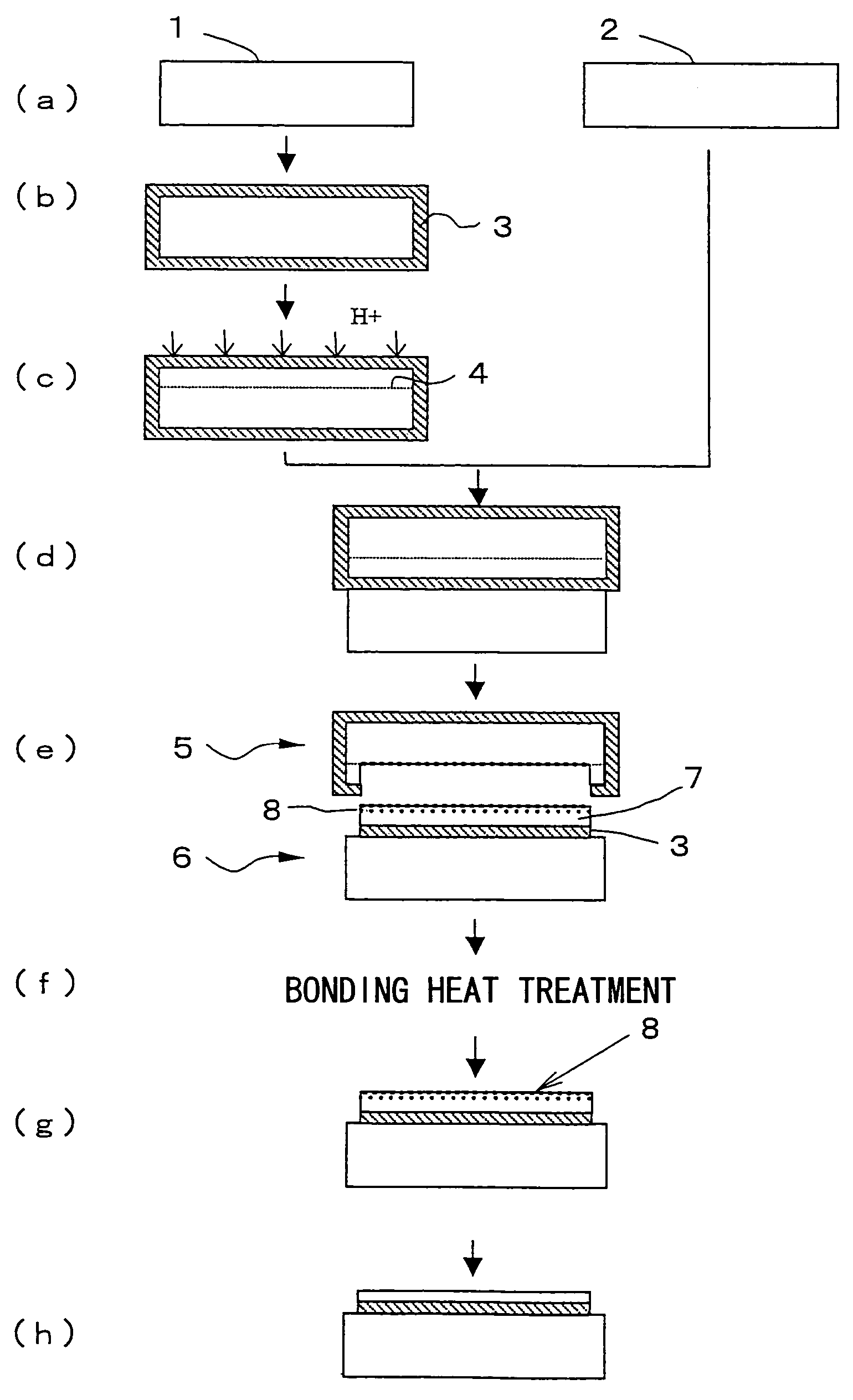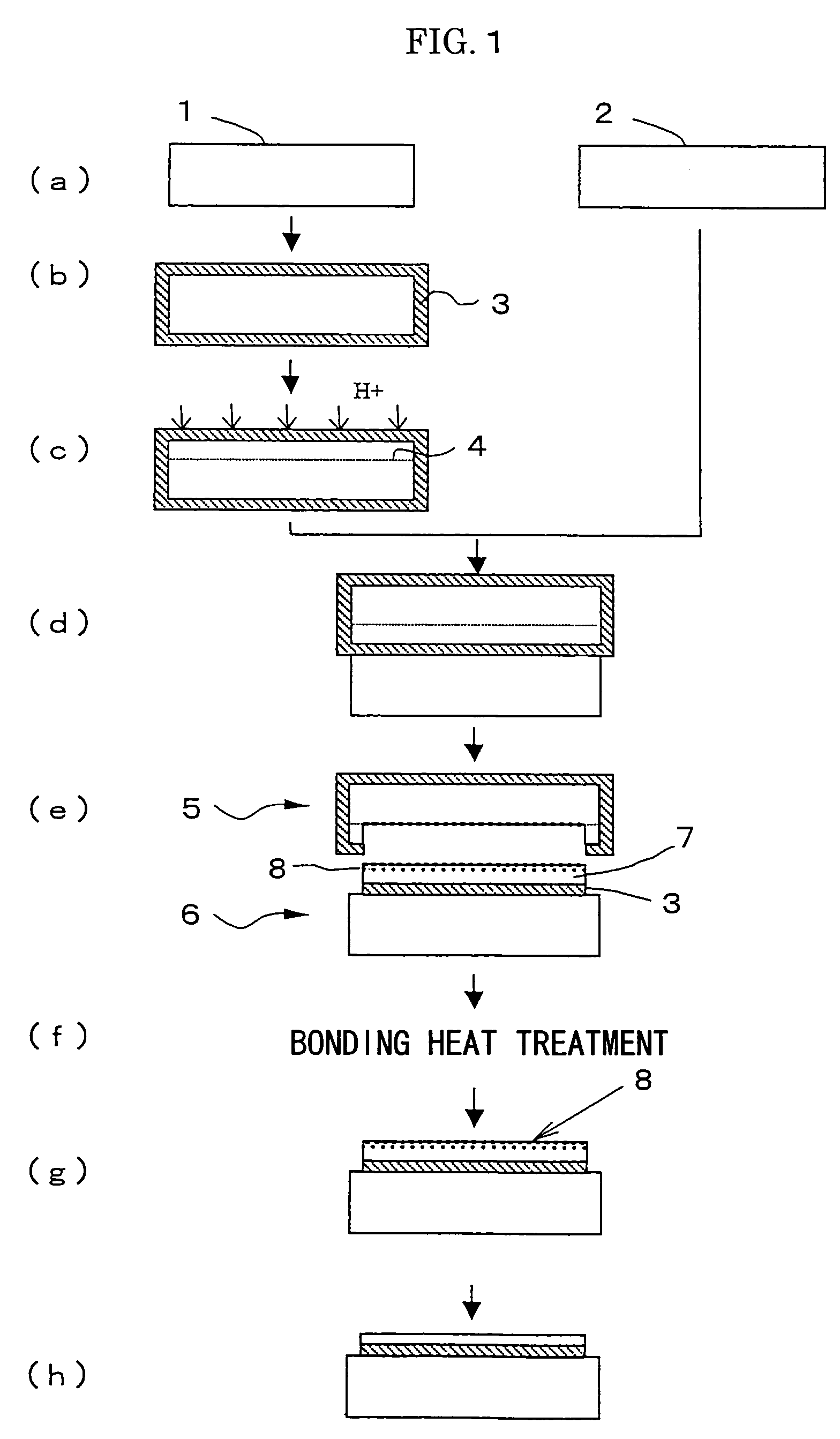Method of manufacturing an SOI wafer where COP's are eliminated within the base wafer
a technology of soi and base wafers, applied in the direction of basic electric elements, electrical apparatus, semiconductor devices, etc., can solve the problems of micro voids, and achieve the effects of reducing costs, improving yield, and improving inspection yield
- Summary
- Abstract
- Description
- Claims
- Application Information
AI Technical Summary
Benefits of technology
Problems solved by technology
Method used
Image
Examples
example 1
[0065]By using a so-called MCZ method in which a magnetic field is applied to a silicon melt, a silicon single crystal ingot was grown at a pulling rate of 1.8 mm / min. This silicon crystal ingot was processed into silicon wafers by slicing, etching, polishing, and the like, and wafers having a crystal orientation of , a conductivity type of P-type, a resistivity of 10 Ω·cm, and a diameter of 200 mm were produced.
[0066]The silicon wafers were subjected to a heat treatment using an RTA apparatus (Rapid Thermal Annealler: a rapid heating / rapid cooling apparatus, SHS-2800, manufactured by AST Corporation) under an atmosphere of 100% hydrogen, at 1200° C., for 10 seconds. In order to use the wafers as both a bond wafer and a base wafer, each surface to be bonded was polished with a stock removal of 10 nm so that haze and the like generated due to the heat treatment on the wafer surface were removed.
[0067]By using such a bond wafer and a base wafer, an SOI wafer of which SOI layer has a t...
example 2
[0074]A silicon single crystal ingot was grown under the same conditions as in Example 1 except that the ingot was doped with nitrogen of 1×1014 atoms / cm3. The single crystal ingot was processed into silicon wafers by slicing, etching, polishing, and the like, and thereby wafers having a crystal orientation of , a conductivity type of P-type, a resistivity of 10 Ω·cm, and a diameter of 200 mm were produced.
[0075]Such wafers are used as a bond wafer and a base wafer, and an SOI wafer was produced by the same processes and production conditions as in Example 1. And then, the number of COPs was observed by the particle counter as in Example 1.
[0076]As a result, the number of COPs observed on the wafer was 7 numbers / wafer. Also, when cross sections of points where the COPs exist were observed by the TEM, it was found that COPs generated on the base wafer were 4 numbers / wafer. However, micro voids did not exist therein.
example 3
[0077]The same crystal ingot as in Example 2 was processed into wafers by slicing, etching, polishing, and the like, and wafers having a crystal orientation of , a conductivity type of P-type, a resistivity of 10 Ω·cm, and a diameter of 200 mm were obtained.
[0078]Such silicon wafers were subjected to a heat treatment under an atmosphere of argon gas at 1200° C. for 1 hour. In order to use the wafers as both a bond wafer and a base wafer, each surface to be bonded was polished with a stock removal of 10 nm so that haze and the like generated due to the heat treatment on each wafer surface were removed.
[0079]By using the bond wafer and the base wafer, an SOI wafer was produced under the same processes and production conditions as in Example 1. And then, the number of COPs was observed by the particle counter as in Example 1.
[0080]As a result, the number of COPs observed on the wafer was 1 number / wafer. Also, when a cross section of the points where the COP exists was observed by the T...
PUM
 Login to View More
Login to View More Abstract
Description
Claims
Application Information
 Login to View More
Login to View More - R&D
- Intellectual Property
- Life Sciences
- Materials
- Tech Scout
- Unparalleled Data Quality
- Higher Quality Content
- 60% Fewer Hallucinations
Browse by: Latest US Patents, China's latest patents, Technical Efficacy Thesaurus, Application Domain, Technology Topic, Popular Technical Reports.
© 2025 PatSnap. All rights reserved.Legal|Privacy policy|Modern Slavery Act Transparency Statement|Sitemap|About US| Contact US: help@patsnap.com



